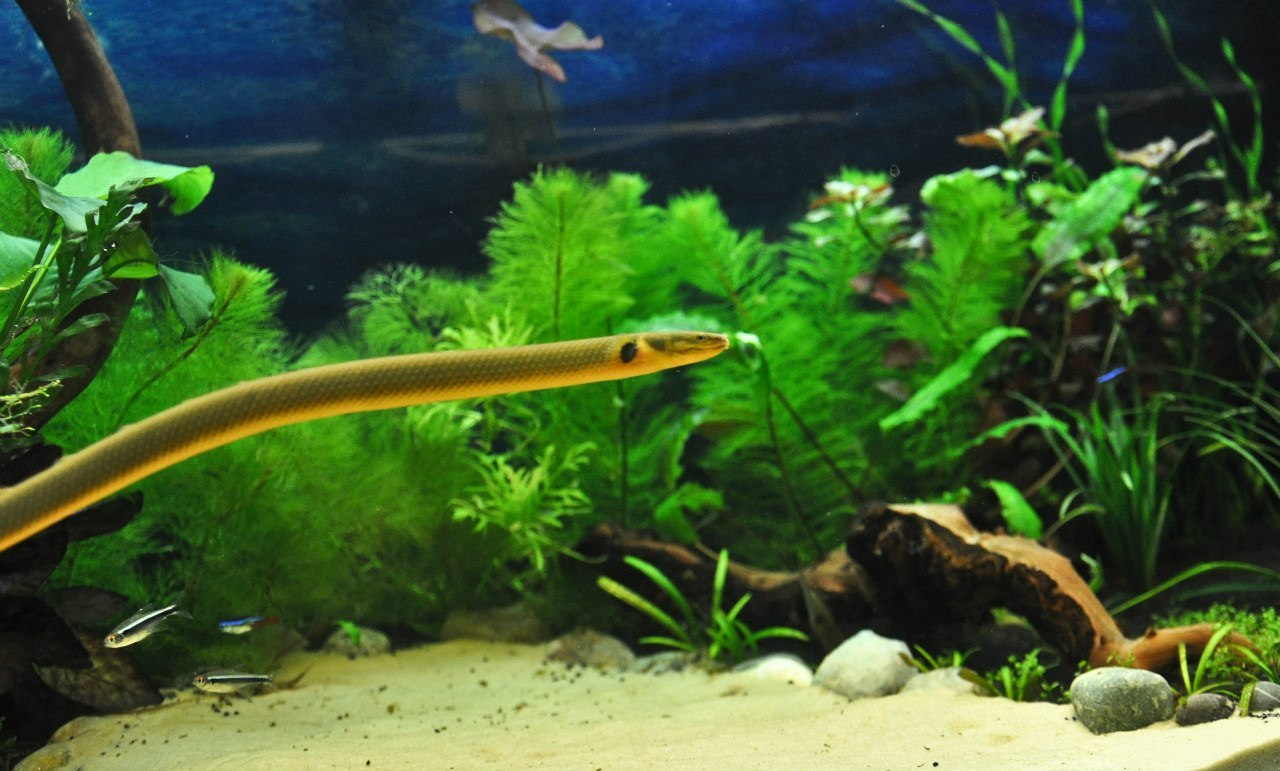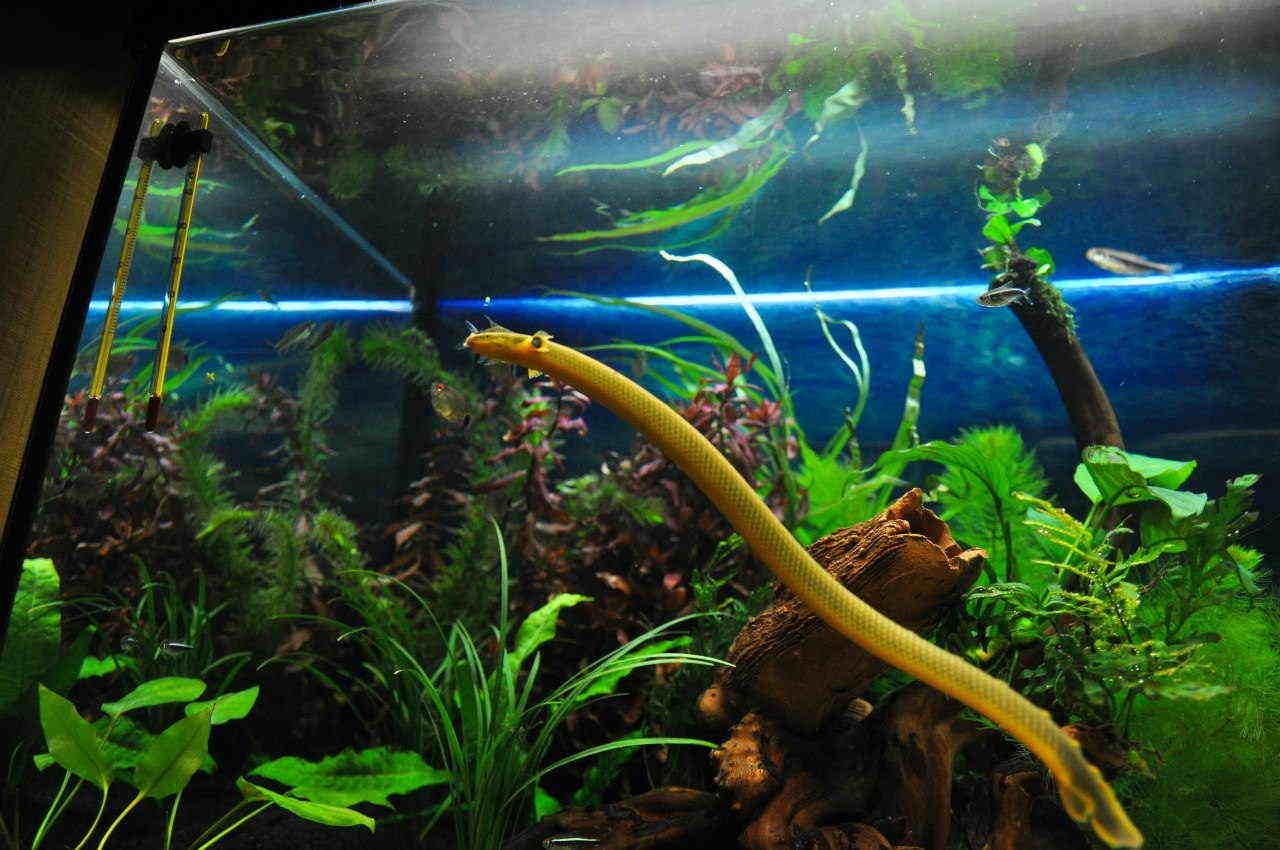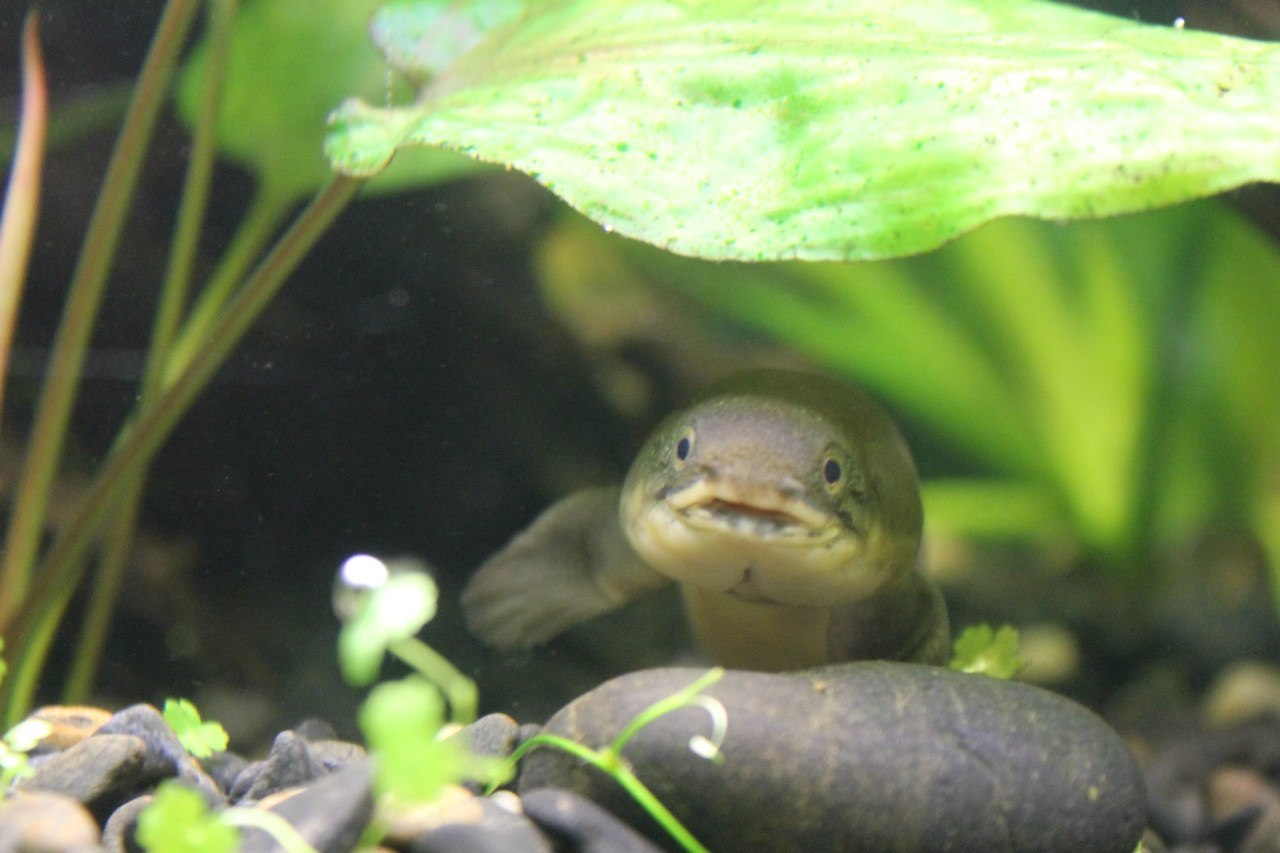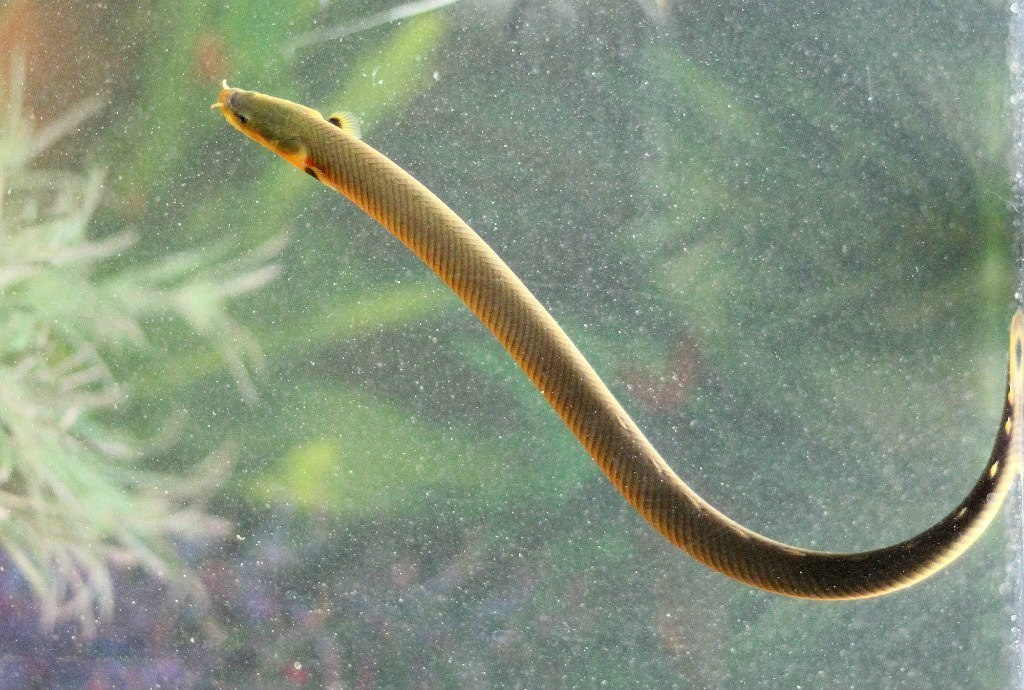The rope fish (Erpetoichthys calabaricus), is a species of freshwater fish in the bichir family, popular aquarium fish. It is interesting to watch reed fish in a tank, easy to keep it but you should bare in mind that its tank mates must be average or large sized. Rope fish takes smaller fish species as a food, since it is a predator by its nature.

Contents
Habitat in the wild
The rope fish (Erpetoichthys calabaricus) belongs to the family Polypteridae. The family Polypteridae is a small group of freshwater fish known as “bichirs” or “ropefish” and is found primarily in Africa. They are ancient fish with a unique appearance, characterized by their elongated and snake-like bodies, hence the name “ropefish.”
The genus is spread in West Africa. The rope fish habitat stretches from Benin to Cameroon, at that the fish is most often encountered in Niger river delta. It prefers freshwater rivers and lakes, but you can also see it in brackish water basins. Predator fishes as a rule are active at twilight and at night. This one feeds on small animals, but first of all on insects and worms. African rope fish looks for food by means of its organ of smell, since the fish has rather poor eyesight.
Bichirs are interesting creatures with several distinctive features:
- Primitive characteristics: Bichirs are often considered “living fossils” because they exhibit primitive characteristics similar to early fish species that lived millions of years ago. They have thick, bony scales, paired lobed fins, and can breathe both through their gills and modified swim bladders, which function as lungs.
- Nocturnal behavior: Rope fish are mainly active during the night, and they have a tendency to hide during the daytime. They prefer slow-moving or stagnant waters with plenty of hiding spots like plants, rocks, or driftwood.
- Predatory habits: Bichirs are carnivorous and primarily feed on small fish, insects, crustaceans, and other aquatic organisms. Their long, slender bodies and sharp teeth are adaptations for catching and consuming prey.
- Partial air-breathers: Bichirs possess a unique respiratory system that allows them to gulp air at the water’s surface, which is an adaptation for surviving in oxygen-depleted waters. They can use both gills and a modified swim bladder (lung) to respire.
- Adaptability: Rope fish are hardy and adaptable, which makes them suitable for aquarium keeping. However, they can grow quite large (up to 20 inches or more), so they require a spacious tank with plenty of hiding spots and a secure lid to prevent escape.
Description
Everything about rope fish is uncommon – its behavior in a tank, appearance and even its name. It has several ones: ropefish (or rope fish), reed fish, snakefish, african rope fish. But all these names denote one and the same species.
Size
Rope fish has a long smooth body, that is up to 20 in (50 cm) long in the wild. In a tank the fish grows to become up to 37 cm (15 in). However, some individuals have been known to exceed 20 inches under optimal conditions.
Lifespan
There is no exact information about the lifespan, but according to info got from aquarists who have such a fish – it has been living more than 10 years already. Some well-cared-for rope fish have been known to live longer than 15 years, while others may have shorter lifespans if not kept in optimal conditions.
Body
Rope fish – the name itself says about the appearance. The thing is not only about its body shape, but also about its diamond shaped scales, which usually have light greenish or brownish tint on upper side of the body and beige-yellow tint over abdomen area.
Pectoral fins of the fish are orange or yellow and they make it look a bit funny, since they are close to its head and look like “ears”. So when you watch fish in a tank it seems that it is swimming and waving its ears fast.
In the wild these fish inhabit mainly in lentic or slowly flowing waters with low oxygen content. Due to this the fish has rather poorly developed sight and its main sensory organ is sense of touch and smell.
Because of low oxygen content in water rope fish has got used to get to water surface from time to time and breathe with atmospheric air. They even have lungs for this, with their help the reed fish can stay out of water for some time (at the condition of high humidity outside).
| Characteristic | Description |
|---|---|
| Scientific Name | Erpetoichthys calabaricus |
| Common Names | Rope fish, Reed fish, Snake fish |
| Family | Polypteridae |
| Origin | West and Central Africa |
| Size | Can grow up to 20 inches (50 cm) or more |
| Lifespan | Around 10-15 years in captivity |
| Habitat | Slow-moving or stagnant waters with hiding spots |
| Behavior | Nocturnal, prefers hiding during the day |
| Diet | Carnivorous, feeds on small fish, insects, etc. |
| Respiration | Can breathe through gills and modified swim bladder (lung) |
| Appearance | Elongated, snake-like body with thick, bony scales |
| Tank Size | Requires a spacious tank due to their size |
| Tank Setup | Plenty of hiding spots, plants, and driftwood |
| Compatibility | Generally peaceful, but can be predatory |
| Care Level | Intermediate, requires proper water conditions |
| Special Considerations | Need a secure tank lid to prevent escape |

Difficulties in keeping
Just like bichir this one is not demanding either, but it requires some specific tank conditions and tank mates to keep it successfully. Therefore, it can’t be recommended to beginners, but for experienced aquarists care won’t be a challenging task.

Keeping in a tank
Is a typical night predator – its is deliberate, cagey and a bit slow. Though the rope fishis active mainly at night, it becomes more active at day and hides less if you regularly feed it during a day.
Tank size
Rope fish can grow quite large, reaching up to 20 inches (50 cm) or more in length. As a result, they require a spacious aquarium to accommodate their size and provide them with a comfortable environment.
The recommended minimum tank size for a single adult rope fish is around 75 gallons (284 liters) or larger. However, it’s essential to remember that bigger is always better when it comes to housing large fish like rope fish. Providing a larger tank will give them more swimming space and allow you to create a more natural and enriching environment with hiding spots and plenty of room to explore.
Furthermore, if you plan to keep multiple rope fish or have other tank mates, you’ll need to increase the tank size accordingly. Rope fish are generally peaceful but can be predatory, especially towards smaller fish that can fit in their mouths. Therefore, it’s crucial to choose compatible tank mates and provide enough space to reduce the chances of aggression.
In summary, consider a tank size of at least 75 gallons for a single adult rope fish and larger if you plan to keep more than one or have other fish in the same aquarium. Always prioritize the well-being and comfort of your fish by providing them with an adequately sized and well-maintained environment.
Water parameters
Here are the recommended water parameters for rope fish:
- Temperature: 75°F to 82°F (24°C to 28°C)
- Rope fish prefer slightly warmer water temperatures within this range. Use a reliable aquarium heater to maintain a stable temperature.
- pH Level: 6.5 to 7.5
- Rope fish thrive in slightly acidic to neutral pH levels. Regularly test the water pH and make adjustments if necessary using pH stabilizers.
- Water Hardness: Soft to moderately hard (4 to 15 dGH)
- Rope fish can tolerate a range of water hardness levels, but they generally do well in slightly soft to moderately hard water.
- Ammonia and Nitrite: 0 ppm (parts per million)
- Ammonia and nitrite are toxic to fish, including rope fish. Make sure these levels remain undetectable by using proper filtration and regular water changes.
- Nitrate: Below 40 ppm (preferably lower)
- While rope fish are somewhat tolerant of nitrates, it’s best to keep them at lower levels. Regular water changes will help keep nitrate levels in check.
- Dissolved Oxygen: Adequate oxygen levels
- Aeration is not necessary for a rope fish. Due to its anatomical organization features, it can swallow atmospheric air and take oxygen from it. This process is easy to be seen – from time to time a fish gets to the water surface and takes some air with its mouth and goes back to the tank bottom after that. The rope fish needs free access to the tank surface, otherwise it’ll die from suffocation, since just gill breathing is not enough for it. In general, this fish is a classic representative of bottom dwellers.
- Filtration: Efficient filtration is essential to maintain water quality.
- Use a suitable filter that can handle the tank size and biological load. Since this is a predator, it leaves a lot of organic waste, therefore a canister filter is required.
Remember to regularly test the water parameters using appropriate test kits and perform partial water changes (about 20-25% of the tank volume) on a weekly basis to keep the water quality optimal for your rope fish. Keeping a stable and clean environment will contribute to the health and longevity of your aquatic pets.
Tank decor
Another important thing is that tank must be tightly covered. The thing is that rope fish can justle through any crack and often escapes from tanks. Even the thinnest crack will give the fish a chance to escape and it can travel quite a long a way by land.
If there are any chinks in a tank for tubes and wires, you’d better close them with a sponge. If you are performing water renew, cleaning the tank etc. and you need to leave the tank for some period of time, either ask someone to stay and watch the fish or close the tank tightly with a lid.
Rope fish in a split second can get away from the tank, but it can’t live without water for a long time. Any kind of lighting will do, but it’s desirable to have some dark shelters in a tank, without any bright lighting.
We also must mention, that fish doesn’t take good when you move it from one tank to another, due to this fact it may refuse to eat for several days and even weeks (without any serious harm for the fish itself, though).
Lot’s of shelters in a tank will help your new pet to get accustomed. An unmistakable sign of successful adaptation and that your new tank dweller has found its place in a tank, is that the rope fish has chosen one or two constant shelters, where it spends most of the time.
Diet
The easiest way to feed a rope fish is to give it with large bloodworms or worms. The fish is a predator, so it will hunt small fishes, especially at night.
If you feed the fish with pieces of calamari and prawns – this is good food for it. As for the dry food, for example, pellets for bottom dwellers – fish may eat them sometimes, but this is more likely an exception for it.
The most important thing is to make sure that your rope fish gets food in general and is not starving. This is especially important, if a rope fish has fast and omnivorous tank mates. The thing is that when looking for food a rope fish uses its perfect smell and sense of touch.
The rope fish may swim close to a large bloodworm and won’t see it unless it touches the bloodworm with its barbels. This doesn’t mean that the fish has heavy mind, it is really not easy for a rope fish to find food, when the smell comes from all sides. It’s better to feed the fish 10-15 later after you finish feeding the rest of tank dwellers.
If you feed all of them together, your fish is likely to stay hungry. If you see that the fish has been starving, feed it before turning of the tank lighting or after this.

Tank mates
Are rope fish aggressive? No, but can eat other fish. You will not have any problem with a compatibility. It is important to keep in mind just two points.
Firstly, there shouldn’t be any aggressive cichlids in a tank (flower horn, oscar). Secondly, tank mates must be larger than its mouth – otherwise the fish starts hunting and treat them as its prey. At that, once the fish starts to hunt at night, nothing will make it stop doing this. Some time ago I didn’t take this fact into account and about a dozen of small tiger barbs disappeared from the tank.
Here are some suitable tank mates for rope fish:
- Other Rope Fish: Keeping multiple rope fish together can work well as long as the tank is large enough to accommodate them comfortably. They are social and may enjoy the company of their own kind.
- Bichirs (Polypterus spp.): Some other species of bichirs can coexist with rope fish, provided the tank size is sufficient and there are enough hiding spots for each fish.
- Large, Peaceful Community Fish: Some larger and peaceful community fish can cohabitate with rope fish. Examples include:
- Gouramis (e.g., Pearl Gourami)
- Angelfish (Pterophyllum spp.)
- Silver Dollar Fish (Metynnis spp.)
- Larger Tetras (e.g., Buenos Aires Tetra)
- Bottom-Dwelling Fish: Some bottom-dwelling fish that occupy different areas of the tank can be good tank mates, such as:
- Corydoras Catfish (Corydoras spp.)
- Plecostomus (Plecos) – choose larger species that won’t fit into the rope fish’s mouth
- Non-Aggressive Cichlids: Some non-aggressive cichlids can coexist with rope fish, such as:
- Apistogramma species (e.g., Apistogramma cacatuoides)
- Kribensis (Pelvicachromis pulcher)
Always keep an eye on their interactions, especially during the initial introduction phase. Tank mates should be similar in size or larger than rope fish to avoid any predatory behavior. Additionally, make sure the tank is large enough and provides ample hiding spots for all the inhabitants.
Avoid keeping rope fish with small fish, shrimp, or any species that could be considered prey. Also, aggressive or territorial fish should be avoided, as they may stress the rope fish.
Remember that individual fish may have unique personalities and tolerances, so always be prepared to make adjustments or provide alternative housing if any conflicts arise. Proper research and observation are essential when selecting tank mates to ensure a harmonious and peaceful community tank.
Gender differences: male vs female
The rope fish doesn’t have rather pronounced gender dimorphism.
Distinguishing between male and female rope fish can be challenging, especially when they are young or not sexually mature. Unlike some other fish species, rope fish do not have obvious external differences between males and females, such as coloration or fin shapes. Additionally, there is limited scientific information available on the specific characteristics that differentiate male and female rope fish.
In some cases, sexually mature female rope fish might appear slightly plumper when they are carrying eggs, but this difference might not be noticeable without close observation and experience with the species. In general, the most reliable method to determine the sex of rope fish is through examination of their internal reproductive organs, which requires a more invasive procedure and is typically not done for casual aquarium-keeping purposes.
There is an idea, that you can define by counting rays on its dorsal fin – males have about 12-14 rays and females about – 9-12 rays. Besides, female’s anal fin is smaller that that of a male.
If you have a group of rope fish and are interested in breeding them, the best way to determine the sex of individuals is through observation of their behavior during the breeding season. Males might exhibit more territorial behavior and actively court females, while females might appear more plump when carrying eggs. However, even these behaviors can vary among individuals, making it challenging to differentiate between the sexes accurately.
For most aquarium enthusiasts, distinguishing between male and female rope fish is not necessary for general care and maintenance. If you have a pair or a group of rope fish, focus on providing them with suitable living conditions, proper nutrition, and a well-maintained environment. If breeding is your goal, consider seeking advice from experienced breeders or aquarists who have successfully bred rope fish before.

Breeding
There were described some cases of successful rope fish breeding in home aquariums, but these are very rare events and they don’t demonstrate any systematic character. Therefore, the species you see on sale are caught in the wild or bread in fish hatcheries with the help of hormonal agents.